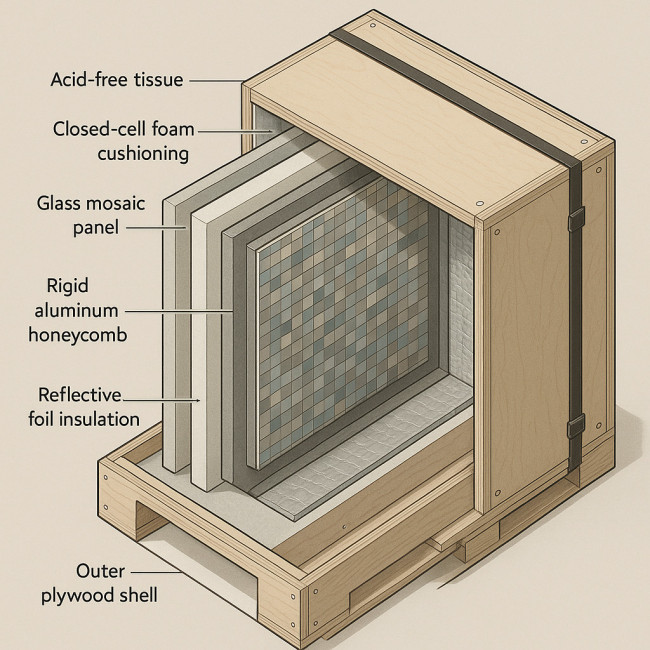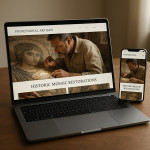Safe crating and freight for oversized mosaics: budget and insurance tips
Shipping a multi-panel mosaic wall or a monumental floor medallion across borders can feel daunting. This guide walks you through proven crating methods, realistic budgeting, and rock-solid insurance tactics so your oversized mosaics arrive intact—and your project margins stay healthy.
Why oversized mosaics demand specialised logistics
Mosaics combine glass, ceramic and grout into rigid but brittle sheets. When those sheets stretch beyond 1 m², vibration, flex and temperature swings become critical threats. Add custom shapes and site deadlines, and you need a freight plan that removes guesswork.
Core risk factors
- Point-load stress on tesserae when forklifts lift unevenly.
- Hairline cracks from temperature shifts in un-insulated holds.
- Moisture ingress that stains porous stone or lime-based grout.
Designing a crate that survives the journey
A crate should act like a shock absorber, climate shield and easy-access archive all at once. Follow the five-layer rule below to meet current advanced packaging specs adopted by museum couriers.
- Contact layer: Acid-free tissue or Tyvek to prevent abrasion.
- Cushion layer: 50–70 mm closed-cell polyethylene foam cut to frame each panel.
- Rigid skeleton: ISPM-15 compliant plywood or aluminium honeycomb.
- Insulation layer: Reflective foil bubble wrap to reduce thermal shock.
- Outer shield: Plywood shell with steel strapping and shock-watch indicators.
Pro tips from art-freight engineers
- Leave a 5 mm breathing gap between panels and the foam cut-out.
- Add grab handles on two sides so crews never tilt the crate beyond 10°.
- Fix a QR code on the lid linking to mounting drawings and unloading notes.
Cost breakdown: what to budget per square metre
| Budget Item | Typical Range (€/m²) | Savings Tips |
|---|---|---|
| Custom crate fabrication | 85 – 140 | Batch crates for multiple panels in one run |
| Inner packing materials | 20 – 35 | Order foam sheets in bulk cuts |
| Freight (air) | 180 – 260 | Negotiate consolidated cargo slots |
| Freight (sea) | 55 – 95 | Book 8 weeks ahead to lock early rates |
| All-risk insurance | 0.8 % – 1.2 % of artwork value | Provide full condition reports to reduce premium |
Choosing the right transport mode
Fast-track hotel lobby installs may justify air freight. Long-lead façade projects often thrive on sea or road. Compare the essentials below.
Air freight
- 48–96 hours door-to-door
- Best for mosaics with delicate gold leaf or smalti that hate humidity
- High cost but lower exposure to handling hubs
Sea freight
- 20–45 days port-to-port
- Affordable for multi-crate shipments if you mitigate salt-laden air
- Require desiccant packs and sealed foil bags inside the crate
Road freight (domestic/regional)
- Flexible pickup times and direct routes
- Ideal for one-off exhibition loans within a single customs zone
- Use temperature-controlled trucks during heatwaves or frosts
Insurance tactics that stop nightmares before they start

Crate specs mean little without a policy tailored to fine art. Many makers still trust the carrier's limited liability—but that caps compensation at freight weight, not artwork value. Instead, mirror the approach detailed in our art shipping insurance workflow. A bespoke “nail-to-nail” all-risk policy covers every handoff from studio lift-gate to final wall anchoring, absorbs the full replacement value, and allows subrogation against subcontractors. Include photo-documented condition reports, serial numbers for each panel, and crate blueprints so underwriters see your risk-mitigation strategy clearly before binding the policy.
Step-by-step cover checklist
- Declare accurate replacement value. Appraisals and sales invoices persuade underwriters.
- Opt for “nail-to-nail” cover. The policy activates from studio pick-up to final installation.
- Photograph every panel. Time-stamped images plus condition reports prove pre-shipment state.
- Add subcontractor clause. Ensures insurers can't deny claims if a third-party forklift driver causes damage.
- Understand exclusions. Non-professional packing voids many policies. Share your crate drawings upfront.
Documentation that trims both costs and claim times
Meticulous paperwork gives carriers fewer reasons to delay and insurers fewer loopholes. Embed these documents inside a clear envelope on the crate exterior:
- Commercial invoice with HS codes 6914 (ceramic) or 7006 (glass)
- Detailed packing list referencing crate ID and panel sequence
- Material Safety Data Sheet if resin or sealant is still curing
- Written handling instructions in two languages
Budget hacks studios overlook
Mosaic ateliers often underestimate hidden charges. Adopt the following tactics to stay on target:
- Carrier-supplied empty weight: Weigh and photograph the crate to dispute volumetric misquotes.
- Shared containers: Band together with other craft studios and split a 20-foot FCL.
- Risk-shared sampling: Ship a small mock-up first using risk-free sample shipments to validate route integrity.
- Broker consolidation: A specialist art broker can bundle multiple policies and cut your premium by up to 15 %.
Smart handoff at destination
Even the best crate loses value if contractors rush the unboxing. Include the installation lead in your freight call so local crews allocate enough labor time. Point them to your dedicated designer profile on Artfolio—mosaic specialist page where they can download mounting diagrams.
Mini-quiz: are you shipment-ready?
FAQ
- Can I reuse crates for return shipments?
- Yes, if moisture sensors remain green and structural integrity is intact. Replace foam inserts that lost rebound to maintain shock absorption.
- What if customs open the crate?
- Attach tamper-evident seals and include clear repacking diagrams. Most officers allow supervised inspection when documentation is thorough.
- Is sea freight ever safe for gold-leaf mosaics?
- Yes, provided you vacuum-seal each panel with desiccant and use container liners that block salt spray.
- How early should I book insurance?
- Secure your policy before fabrication ends. Underwriters often ask for in-process photos to check build quality.
Next steps
Review your crate drawings, gather bid requests from at least two fine-art forwarders, and share this article with your installation partner. For deeper knowledge on packing fragile artwork, explore our related guides.
Ready to lock your freight plan? Reach out to an ISPM-15 certified crating shop and request a moisture-sensor-equipped crate today.











